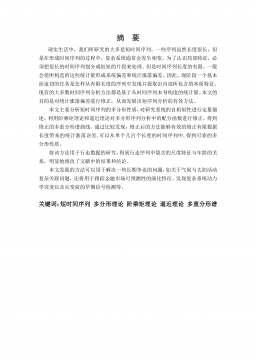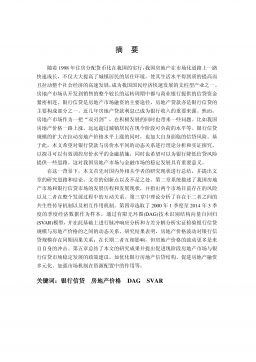基于盐水模型实验大空间下送中回分层空调对流转移热探索
VIP免费
摘要
随着暖通空调技术的不断发展和深入研究,下送中回形式的分层空调逐渐被
应用于大空间建筑。分层空调负荷是确定空调系统设备选型的依据,而关于大空间
下送中回分层空调负荷的计算尚没有统一的方法,其中上部非空调区向下部空调
区转移的对流转移热研究鲜见。本文基于实际大空间建筑,设计并搭建盐水模型实
验台,利用盐水实验测得的垂直密度分布转换为垂直温度分布,与原型垂直温度分
布对比,验证所建实验台的准确度。与此同时,本文利用 PIV 测速技术对建筑中
部回风汇流机理进行研究,获得了回风携带非空调区的空气流占比,即回风占比。
最终在盐水模型测得的垂直温度分布和回风占比的基础上,提出了大空间下送中
回分层空调对流转移热的计算方法。
以相似理论为依据,推导得出原型与盐水模型相关的相似准则数主要为阿基
米德数 Ar,在此基础上,设计了以 1:15 模拟大空间下送中回一对送回风末端空气
流动的盐水模型实验台,该实验台具有如下性能:设计电气控制系统以保证所有管
路集中控制启停和水泵变频调节,盐水回收与循环利用,盐水密度可调等功能,根
据原型实测工况范围,该实验台可运行 12~23min,基本满足实验要求。
结合某大空间夏季实验参数,盐水模型选取 3个实验工况,基于盐水实验结
果的温度分布验证结果表明,与原型垂直温度分布基本接近,尤其是回风区域其温
度斜率基本相近。根据汇流理论原理,应用 PIV 技术实测得到的汇流速度矢量,
获得了二维平面汇流速度半经验公式。由此提出了回风携带上部非空调区风量的
回风占比计算方法,针对变风量的两组实验工况,其平均回风占比分别为 34.09%
和33.13%。
利用盐水模型实验获得的垂直温度分布及回风占比,提出了利用热平衡和回
风占比的两种对流转移热计算方法。采用这两种方法对由原型确定的 3个实验工
况进行计算,结果表明,两种方法得到对流转移热在总负荷的比例其偏差分别为
7.78%、7.94%和10.10%,两种计算方法得到了互证。论文针对变风量的两组实验
工况进行对流转移热计算,结果表明,对流转移热比例随系统风量和室内热量的增
大均有所增大。
论文借助盐水实验结果,分析大空间建筑下送中回分层空调对流转移热的形
成的机理进而获得其确定方法,研究结论能够为实际大空间下送中回分层空调上
部非空调区向下部空调区转移的对流转移热研究提供参考指导。
关键词:大空间 分层空调 下送中回 盐水模型实验 PIV 对流转移热
ABSTRACT
Along with the rapid development and in-depth research of HVAC technology,
stratified air-conditioning with the form of low-sidewall air supply and medium-height
air return is gradually applied in the large space building. The cooling load of stratified
air conditioning is a basis for determining equipment selection in air-conditioning system.
However, there is still no unified method to calculate the cooling load of stratified air-
conditioning with the form of low-sidewall air supply and medium-height air return, the
convective heat transfer from the upper non-air-conditioning area to the lower air-
conditioning area is one kind of the cooling load. In this thesis, the design and
establishment of salt-bath scaled model was based on an actual large space building.
Through comparison between the vertical temperature distribution which was measured
in the prototype large space and the vertical temperature distribution converted from the
vertical density distribution which was measured in salt-bath scaled model, degree of
accuracy of the salt-bath scaled model was verified. Meanwhile, mechanism of the air
return in medium height of the large space was studied by using of Particle Image
Velocimetry (PIV) technique to gain air volume proportion which inhaled from the upper
non-air-conditioning area by air return. Finally, the computational method of convective
heat transfer from the upper non-air-conditioning area to the lower air-conditioning area
in large space air-conditioned with low-sidewall air supply and medium-height air return
was put forward on the basis of the vertical temperature distribution and the air volume
proportion measured in the salt-bath scaled model.
According to the similarity theory, the major relevant similarity criterion between
the prototype and the salt-bath scaled model was Archimedes number Ar, and a salt-bath
scaled model experiment table on the scale of 1:15 was established to simulate air flow
under the airflow organization of one pair of air supply and air return outlets in the
prototype large space air-conditioned with the form of low-sidewall air supply and
medium-height air return. The experiment table has the following performance: 1) The
startup and stop of all pipelines were centralized controlled and all water pumps can
realize frequency conversion, 2) The recycling and cyclic utilization of salt water, 3) The
density of salt water can be adjusted and etc. The experiment table can run about 12~23
minutes according to experiment conditions in prototype, which basically met the
experimental requirements.
Three experimental conditions were selected in the salt-bath scaled model
experiment combined with the experimental parameters on summer of an actual large
space. The experimental results showed that the vertical temperature distribution gained
from the salt-bath scaled model and the vertical temperature distribution measured from
the actual large space was basically close, especially the temperature gradient around the
air return region.According to the confluence flow theory combined with velocity vector
measured by PIV, the two-dimensional flow velocity semi-empirical formula was gained.
Thus, A computational method of air volume proportion inhaled from the upper air-
conditioning area was put forward, and the average air volume proportion of two variable
air volume experimental conditions was 34.09% and 33.13%, respectively.
According to the vertical temperature distribution gained from the salt-bath scaled
model and air volume proportion, two computational methods (one based on thermal
balance and the other based on air volume proportion) of convective heat transfer were
put forward. In the three experimental conditions converted from the prototype, the
convective heat transfer was computed by the aboved two computational methods. The
results showed that the deviation of convective heat transfer in the proportion of the total
load were 7.15%, 3.18% and 9.72%, respectively, thus the aboved two computational
methods were mutually verified. The computational results of convective heat transfer
under two variable air volume experimental conditions showed that the convective heat
transfer proportion increased as the system air volume and indoor quantity of heat
increased
The mechanism and computational method of the convective heat transfer in large
space with the form of low-sidewall air supply and medium-height air return were
analyzed on the basis of measured results in salt-bath scaled model experiment. The
conclusion provided guideline to the research of the convective heat transfer from the
upper non-air-conditioning area to the lower air-conditioning area in the actual large space
with the form of low-sidewall air supply and medium-height air return.
Key Word: Large Space, Stratified Air-conditioning, Low-sidewall Air
Supply And Medium-height Air Return, Salt-bath Scaled Model
Experiment, Particle Image Velocimetry (PIV),
Convective Heat Transfer
目录
中文摘要
ABSTRACT
第一章 绪论 ......................................................... 1
1.1 本文研究背景 ................................................. 1
1.2 国内外研究现状 ............................................... 2
1.2.1 下送风热环境研究现状 ................................... 2
1.2.2 盐水模型实验研究现状 ................................... 4
1.2.3 室内气流运动应用 PIV 测试技术的研究及现状 ............... 6
1.3 主要研究内容及意义 ........................................... 9
1.3.1 研究思路及研究内容 ..................................... 9
1.3.2 研究意义 .............................................. 10
第二章 盐水模型实验台设计与搭建 .................................... 11
2.1 盐水模型实验台设计目标和要求 ................................ 12
2.1.1 盐水模型实验台设计目标 ................................ 12
2.1.2 盐水模型实验台设计要求 ................................ 12
2.2 大空间下送中回分层空调盐水模型实验相似性分析 ................ 13
2.2.1 盐水模型相似原理 ...................................... 13
2.2.2 基于盐水实验的相似准则数 .............................. 14
2.2.3 盐水实验相似准则数及其主要比例尺的确定 ................ 16
2.2.4 热源羽流相似比例尺的确定 .............................. 18
2.2.5 盐水模型实验参数的确定方法 ............................ 20
2.3 盐水模型实验台设计及搭建 .................................... 22
2.3.1 盐水模型实验台系统设计 ................................ 22
2.3.2 实验台各水箱设计 ...................................... 25
2.3.3 实验台系统设备和仪器选型 .............................. 29
2.3.4 各盐水供回装置设计及制作 .............................. 33
2.3.5 实验台系统电气控制设计 ................................ 35
2.3.6 盐水回收与循环利用系统设计 ............................ 38
2.4 盐水模型实验测量值不确定度分析 .............................. 39
2.4.1 实验台测量不确定度原理 ................................ 39
2.4.2 基于盐水模型实验结果的流量不确定度 .................... 40
2.4.3 基于盐水模型实验结果的温度不确定度 .................... 42
2.5 小结 ........................................................ 44
第三章 基于盐水模型大空间下送中回分层空调垂直温度分布实验研究 ...... 46
3.1 实验目的与实验内容 .......................................... 46
3.1.1 实验目的 .............................................. 46
3.1.2 实验内容 .............................................. 46
3.2 盐水模型实验设计 ............................................ 47
3.2.1 模型实验参数设定 ...................................... 47
3.2.2 盐水模型实验原理 ...................................... 49
3.2.3 盐水模型实验方法 ...................................... 51
3.3 基于盐水模型的垂直温度分布验证 .............................. 53
3.3.1 测点布置 .............................................. 53
3.3.2 实验结果及验证分析 .................................... 54
3.4 垂直温度分布变风量特性实验结果与分析 ........................ 58
3.5 小结 ........................................................ 61
第四章 粒子图像测速技术(PIV)原理及应用 ........................... 62
4.1 粒子图像测速(PIV)技术测试原理 ............................. 62
4.1.1 PIV 测速技术简介 ...................................... 62
4.1.2 PIV 技术测试原理 ...................................... 63
4.1.3 PIV 测速系统组成 ...................................... 63
4.2 互相关分析法在 PIV 测试技术中的应用 .......................... 68
4.3 PIV 测速技术关键问题的讨论 .................................. 70
4.3.1 示踪粒子与流体的速度幅值比对流场测试结果影响分析 ...... 70
4.3.2 示踪粒子时滞时间和沉降速度对流场测试结果影响分析 ...... 73
4.3.3 激光脉冲时间间隔t选定 ................................ 76
4.3.4 双脉冲激光与 CCD 相机工作时序设置 ..................... 77
4.3.5 双脉冲激光强度设置 .................................... 78
第五章 基于盐水模型大空间下送中回分层空调回风口汇流流场研究 ........ 80
5.1 基于 PIV 技术下送中回回风口流动特性实验方案 .................. 80
5.1.1 实验目的和实验内容 .................................... 80
5.1.2 模型回风汇流区域速度矢量场测试方法 .................... 80
5.2 回风汇流速度分布数学模型 .................................... 87
5.2.1 点汇汇流原理 .......................................... 87
5.2.2 线汇流微元叠加方法 .................................... 87
5.2.3 基于规划求解的汇流二维速度分布计算原理 ................ 89
5.3 二维汇流速度半经验公式修正 .................................. 90
5.3.1 实验工况和实验结果 .................................... 90
5.3.2 下送中回变风量回风汇流二维速度分布求解 ................ 91
5.4 下送中回分层空调回风携带非空调区的回风占比 .................. 92
5.5 小结 ........................................................ 96
第六章 基于盐水模型大空间下送中回分层空调对流转移热计算方法研究 .... 97
6.1 两种对流转移热计算方法的提出与比较 .......................... 97
6.1.1 两种对流转移热计算方法的提出 .......................... 97
6.1.2 两种对流转移热计算方法比较分析 ........................ 98
6.2 变风量对流转移热计算结果及分析 ............................. 100
6.3 小结 ....................................................... 104
第七章 总结与展望 ................................................. 105
7.1 总结 ....................................................... 105
7.2 不足与展望 ................................................. 107
参考文献 .......................................................... 109
在读期间公开发表的论文和承担的科研项目 ............................ 113
致谢 .............................................................. 114
相关推荐
-
七年级数学下册(易错30题专练)(沪教版)-第13章 相交线 平行线(原卷版)VIP免费
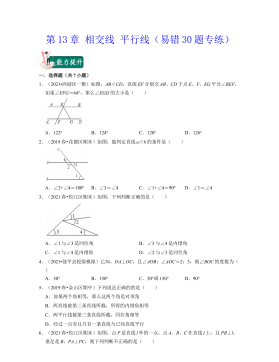
 2024-10-14 25
2024-10-14 25 -
七年级数学下册(易错30题专练)(沪教版)-第13章 相交线 平行线(解析版)VIP免费
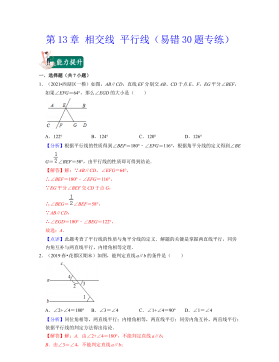
 2024-10-14 28
2024-10-14 28 -
七年级数学下册(易错30题专练)(沪教版)-第12章 实数(原卷版)VIP免费
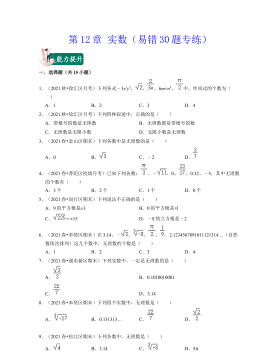
 2024-10-14 25
2024-10-14 25 -
七年级数学下册(易错30题专练)(沪教版)-第12章 实数(解析版)VIP免费
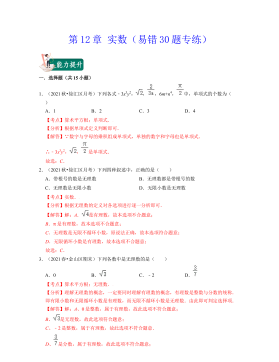
 2024-10-14 19
2024-10-14 19 -
七年级数学下册(压轴30题专练)(沪教版)-第15章平面直角坐标系(原卷版)VIP免费
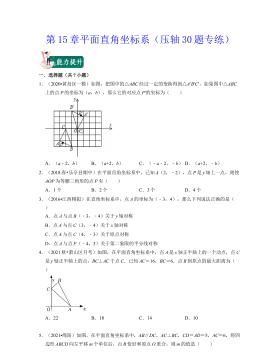
 2024-10-14 18
2024-10-14 18 -
七年级数学下册(压轴30题专练)(沪教版)-第15章平面直角坐标系(解析版)VIP免费

 2024-10-14 27
2024-10-14 27 -
七年级数学下册(压轴30题专练)(沪教版)-第14章三角形(原卷版)VIP免费

 2024-10-14 18
2024-10-14 18 -
七年级数学下册(压轴30题专练)(沪教版)-第14章三角形(解析版)VIP免费

 2024-10-14 30
2024-10-14 30 -
七年级数学下册(压轴30题专练)(沪教版)-第13章 相交线 平行线(原卷版)VIP免费
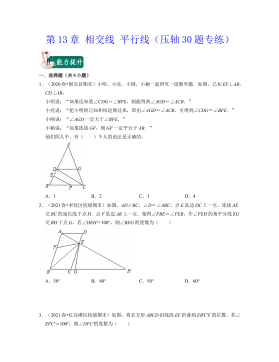
 2024-10-14 25
2024-10-14 25 -
七年级数学下册(压轴30题专练)(沪教版)-第13章 相交线 平行线(解析版)VIP免费
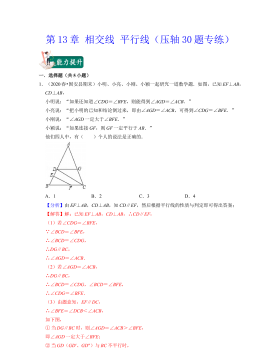
 2024-10-14 22
2024-10-14 22
作者:侯斌
分类:高等教育资料
价格:15积分
属性:118 页
大小:7.27MB
格式:PDF
时间:2025-01-09
相关内容
-

七年级数学下册(压轴30题专练)(沪教版)-第15章平面直角坐标系(原卷版)
分类:中小学教育资料
时间:2024-10-14
标签:无
格式:DOCX
价格:15 积分
-

七年级数学下册(压轴30题专练)(沪教版)-第15章平面直角坐标系(解析版)
分类:中小学教育资料
时间:2024-10-14
标签:无
格式:DOCX
价格:15 积分
-

七年级数学下册(压轴30题专练)(沪教版)-第14章三角形(原卷版)
分类:中小学教育资料
时间:2024-10-14
标签:无
格式:DOCX
价格:15 积分
-

七年级数学下册(压轴30题专练)(沪教版)-第14章三角形(解析版)
分类:中小学教育资料
时间:2024-10-14
标签:无
格式:DOCX
价格:15 积分
-

七年级数学下册(压轴30题专练)(沪教版)-第13章 相交线 平行线(原卷版)
分类:中小学教育资料
时间:2024-10-14
标签:无
格式:DOCX
价格:15 积分


